check oil SKODA OCTAVIA 2009 2.G / (1Z) Owner's Manual
[x] Cancel search | Manufacturer: SKODA, Model Year: 2009, Model line: OCTAVIA, Model: SKODA OCTAVIA 2009 2.G / (1Z)Pages: 304, PDF Size: 19.56 MB
Page 17 of 304
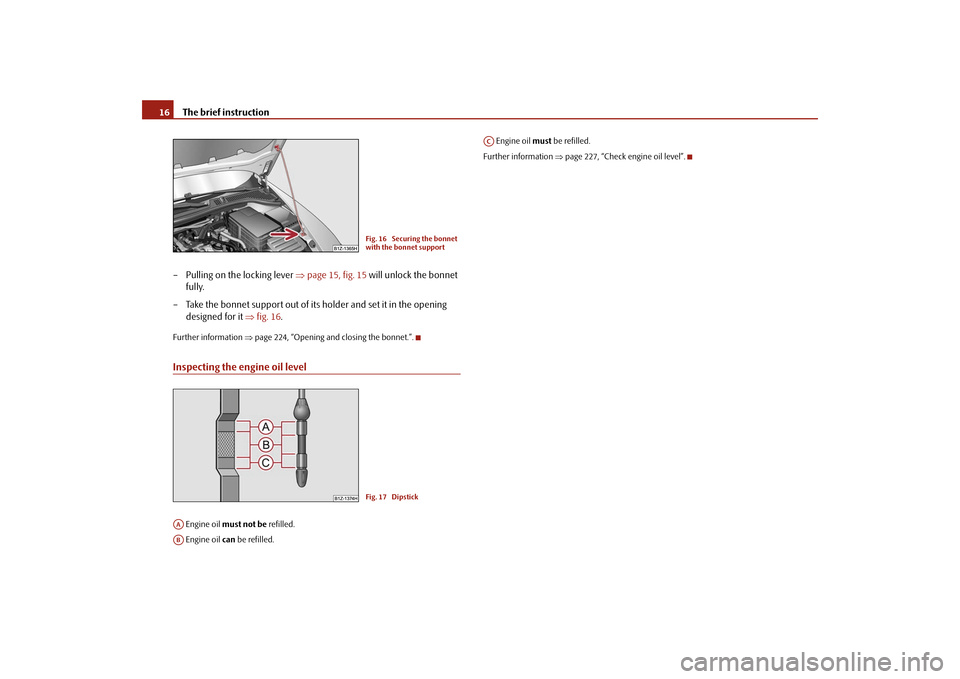
The brief instruction
16
– Pulling on the locking lever
⇒
page 15, fig. 15
will unlock the bonnet
fully.
– Take the bonnet support out of its holder and set it in the opening
designed for it
⇒
fig. 16
.
Further information
⇒page 224, “Opening and closing the bonnet.”.
Inspecting the engine oil level Engine oil
must not be
refilled.
Engine oil
can
be refilled.
Engine oil
must
be refilled.
Further information
⇒page 227, “Check engine oil level”.
Fig. 16 Securing the bonnet with the bonnet supportFig. 17 Dipstick
AAAB
AC
se0.1.book Page 16 Friday, April 10, 2009 3:19 PM
Page 29 of 304
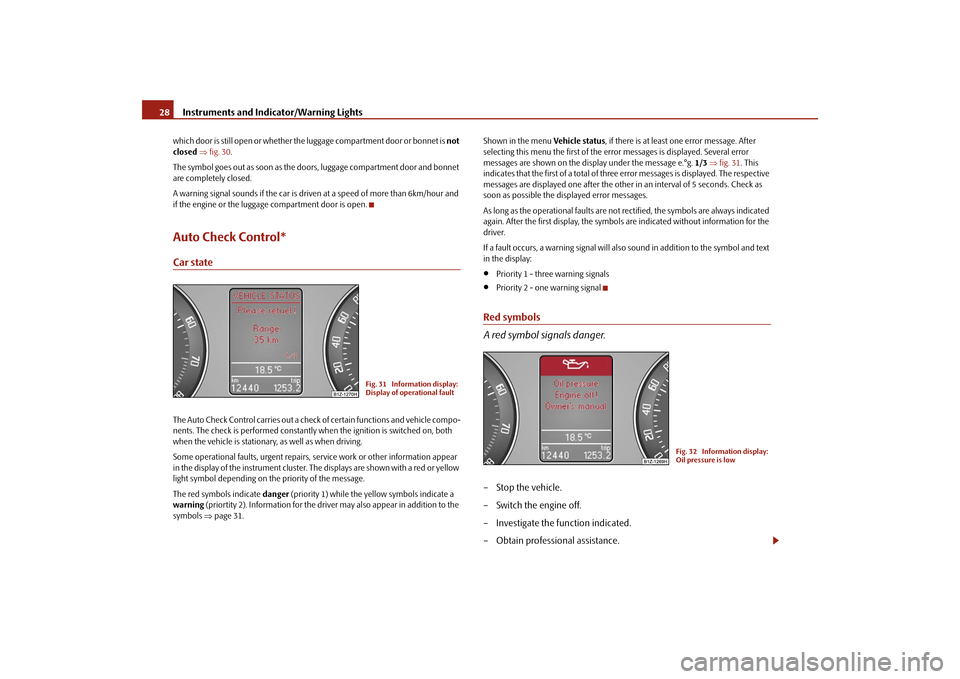
Instruments and Indicator/Warning Lights
28
which door is still open or whether the luggage compartment door or bonnet is
not
closed
⇒fig. 30
.
The symbol goes out as soon as the doors, luggage compartment door and bonnet are completely closed. A warning signal sounds if the car is driven at a speed of more than 6km/hour and if the engine or the luggage compartment door is open.Auto Check Control*Car stateThe Auto Check Control carries out a check of certain functions and vehicle compo-nents. The check is performed constantly wh
en the ignition is switched on, both
when the vehicle is stationary, as well as when driving. Some operational faults, urgent repairs,
service work or other information appear
in the display of the instrument cluster. The displays are shown with a red or yellow light symbol depending on the priority of the message. The red symbols indicate
danger
(priority 1) while the yellow symbols indicate a
warning
(priortity 2). Information for the driver
may also appear in addition to the
symbols
⇒page 31.
Shown in the menu
Vehicle status
, if there is at least one error message. After
selecting this menu the first of the error messages is displayed. Several error messages are shown on the display under the message e.°g.
1/3
⇒fig. 31
. This
indicates that the first of a total of three error messages is displayed. The respective messages are displayed one after the other in an interval of 5 seconds. Check as soon as possible the displayed error messages. As long as the operational faults are not rectified, the symbols are always indicated again. After the first display, the symbol
s are indicated without information for the
driver. If a fault occurs, a warning signal will also sound in addition to the symbol and text in the display:•
Priority 1 - three warning signals
•
Priority 2 - one warning signal
Red symbols A red symbol signals danger.– Stop the vehicle. – Switch the engine off. – Investigate the function indicated.– Obtain professional assistance.
Fig. 31 Information display: Display of operational fault
Fig. 32 Information display: Oil pressure is low
se0.1.book Page 28 Friday, April 10, 2009 3:19 PM
Page 30 of 304
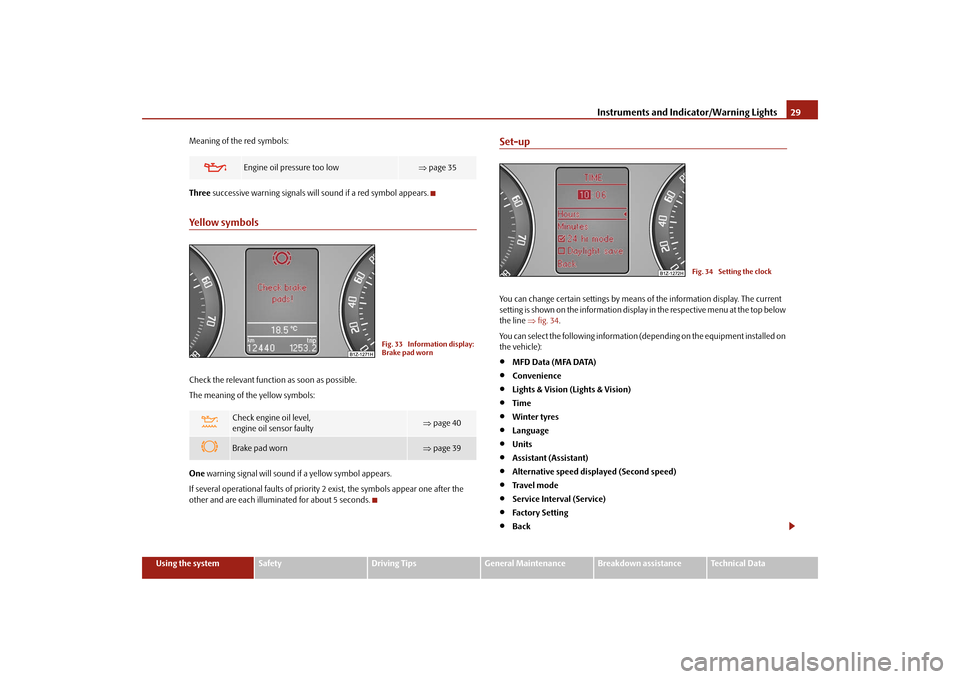
Instruments and Indicator/Warning Lights
29
Using the system
Safety
Driving Tips
General Maintenance
Breakdown assistance
Technical Data
Meaning of the red symbols: Three
successive warning signals will
sound if a red symbol appears.
Yellow symbolsCheck the relevant function
as soon as possible.
The meaning of the yellow symbols: One
warning signal will sound
if a yellow symbol appears.
If several operational faults of priority 2 exist, the symbols appear one after the other and are each illumi
nated for about 5 seconds.
Set-upYou can change certain settings by means
of the information display. The current
setting is shown on the information display in the respective menu at the top below the line
⇒fig. 34
.
You can select the following information (d
epending on the equipment installed on
the vehicle):•
MFD Data (MFA DATA)
•
Convenience
•
Lights & Vision (Lights & Vision)
•
Time
•
Winter tyres
•
Language
•
Units
•
Assistant (Assistant)
•
Alternative speed displayed (Second speed)
•
Tra v e l m o d e
•
Service Interval (Service)
•
Factory Setting
•
Back
Engine oil pressure too low
⇒ page 35
Check engine oil level, engine oil sensor faulty
⇒ page 40
Brake pad worn
⇒page 39
Fig. 33 Information display: Brake pad worn
Fig. 34 Setting the clock
se0.1.book Page 29 Friday, April 10, 2009 3:19 PM
Page 34 of 304
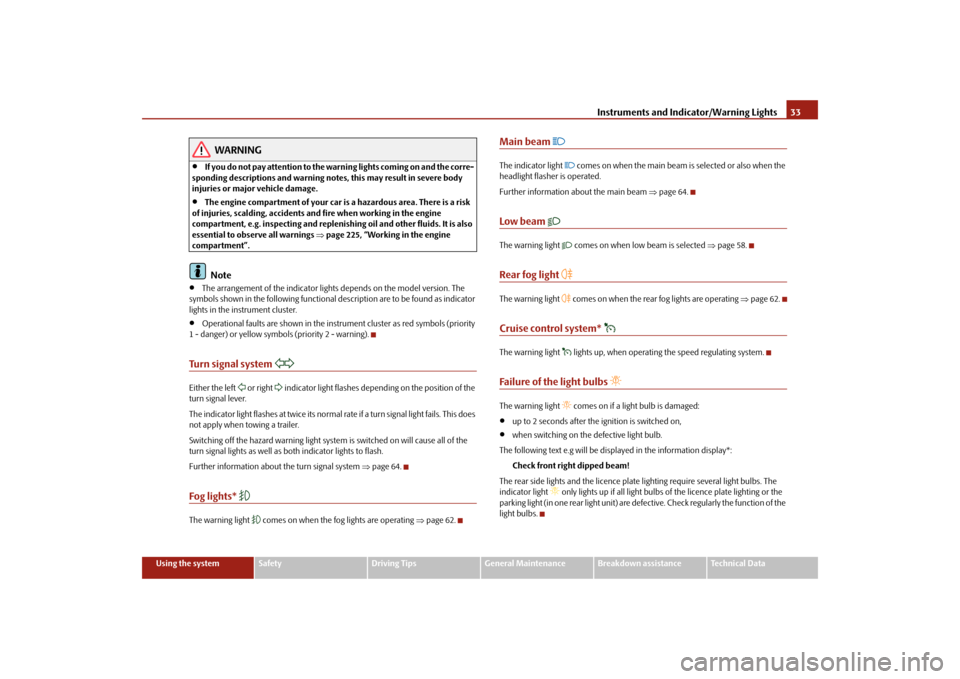
Instruments and Indicator/Warning Lights
33
Using the system
Safety
Driving Tips
General Maintenance
Breakdown assistance
Technical Data
WARNING
•
If you do not pay attention to the warning lights coming on and the corre-
sponding descriptions and warning notes, this may result in severe body injuries or major vehicle damage.•
The engine compartment of your car is
a hazardous area. There is a risk
of injuries, scalding, accidents and
fire when working in the engine
compartment, e.g. inspecting and replenis
hing oil and other fluids. It is also
essential to observe all warnings
⇒page 225, “Working in the engine
compartment”.
Note
•
The arrangement of the indicator lights depends on the model version. The
symbols shown in the following functional description are to be found as indicator lights in the instrument cluster.•
Operational faults are shown in the instrument cluster as red symbols (priority
1 - danger) or yellow symb
ols (priority 2 - warning).
Turn signal system
Either the left
or right
indicator light flashes depending on the position of the
turn signal lever. The indicator light flashes at twice its normal ra
te if a turn signal light fails. This does
not apply when towing a trailer. Switching off the hazard warning light system is switched on will cause all of the turn signal lights as well as
both indicator lights to flash.
Further information about
the turn signal system
⇒page 64.
Fog lights*
The warning light
comes on when the fog lights are operating
⇒page 62.
Main beam
The indicator light
comes on when the main beam is selected or also when the
headlight flasher is operated. Further information about the main beam
⇒page 64.
Low beam
The warning light
comes on when low beam is selected
⇒page 58.
Rear fog light
The warning light
comes on when the rear fog lights are operating
⇒page 62.
Cruise control system*
The warning light
lights up, when operating the speed regulating system.
Failure of the light bulbs
The warning light
comes on if a light bulb is damaged:
•
up to 2 seconds after the ignition is switched on,
•
when switching on the defective light bulb.
The following text e.g will be displayed in the information display*:
Check front right dipped beam!
The rear side lights and the licence plate
lighting require several light bulbs. The
indicator light
only lights up if all light bulbs
of the licence plate lighting or the
parking light (in one rear light unit) are defe
ctive. Check regularly the function of the
light bulbs.
se0.1.book Page 33 Friday, April 10, 2009 3:19 PM
Page 36 of 304
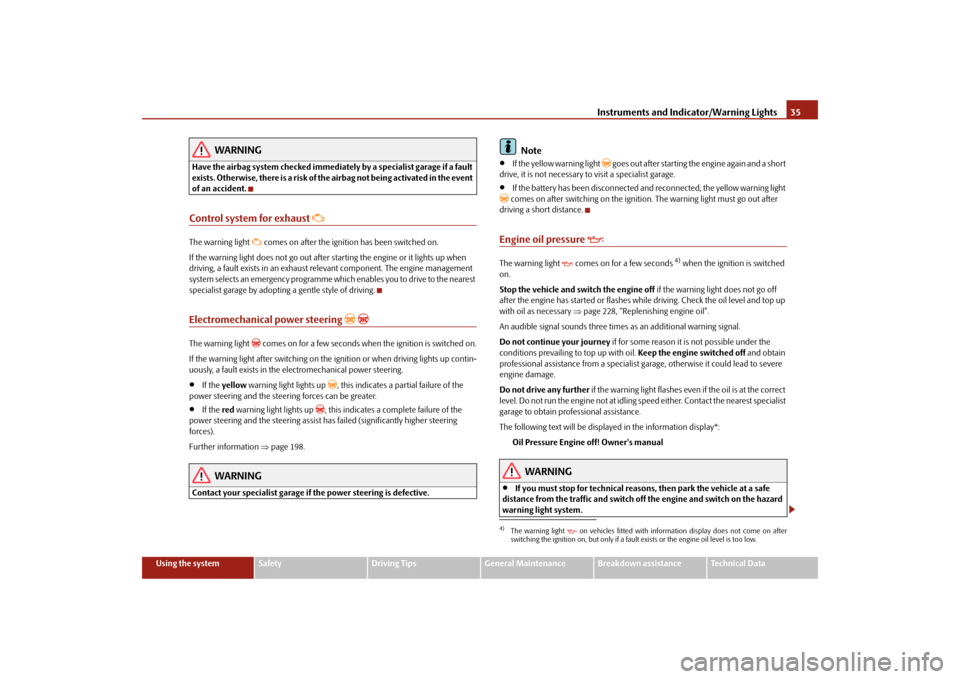
Instruments and Indicator/Warning Lights
35
Using the system
Safety
Driving Tips
General Maintenance
Breakdown assistance
Technical Data
WARNING
Have the airbag system checked immediat
ely by a specialist garage if a fault
exists. Otherwise, there is a risk of th
e airbag not being activated in the event
of an accident.Control system for exhaust
The warning light
comes on after the ignition has been switched on.
If the warning light does not go out after starting the engine or it lights up when driving, a fault exists in
an exhaust relevant componen
t. The engine management
system selects an emergency programme which enables you to drive to the nearest specialist garage by adopting a gentle style of driving.Electromechanical power steering
The warning light
comes on for a few seconds when the ignition is switched on.
If the warning light after switching on the ig
nition or when driving lights up contin-
uously, a fault exists in the el
ectromechanical power steering.
•
If the
yellow
warning light lights up
, this indicates a partial failure of the
power steering and the steering forces can be greater.•
If the
red
warning light lights up
, this indicates a complete failure of the
power steering and the steering assist has failed (significantly higher steering forces). Further information
⇒page 198.
WARNING
Contact your specialist garage if
the power steering is defective.
Note
•
If the yellow warning light
goes out after starting the engine again and a short
drive, it is not necessary to visit a specialist garage.•
If the battery has been disconnected and reconnected, the yellow warning light
comes on after switching on the ignition. The warning light must go out after driving a short distance.Engine oil pressure
The warning light
comes on for a few seconds
4) when the ignition is switched
on. Stop the vehicle and sw
itch the engine off
if the warning light does not go off
after the engine has started or flashes while driving. Check the oil level and top up with oil as necessary
⇒page 228, “Replenishing engine oil”.
An audible signal sounds three times as an additional warning signal.Do not continue your journey
if for some reason it is not possible under the
conditions prevailing
to top up with oil.
Keep the engine switched off
and obtain
professional assistance from a specialist garage, otherwise it could lead to severe engine damage. Do not drive any further
if the warning light flashes even if the oil is at the correct
level. Do not run the engine not at idling
speed either. Contact the nearest specialist
garage to obtain professional assistance. The following text will be displayed in the information display*:
Oil Pressure Engine off! Owner's manual
WARNING
•
If you must stop for technical reasons, then park the vehicle at a safe
distance from the traffic and switch off the engine and switch on the hazard warning light system.4)The warning light
on vehicles fitted with information display does not come on after
switching the ignition on, but only if a fault exists or the engine oil level is too low.
se0.1.book Page 35 Friday, April 10, 2009 3:19 PM
Page 37 of 304
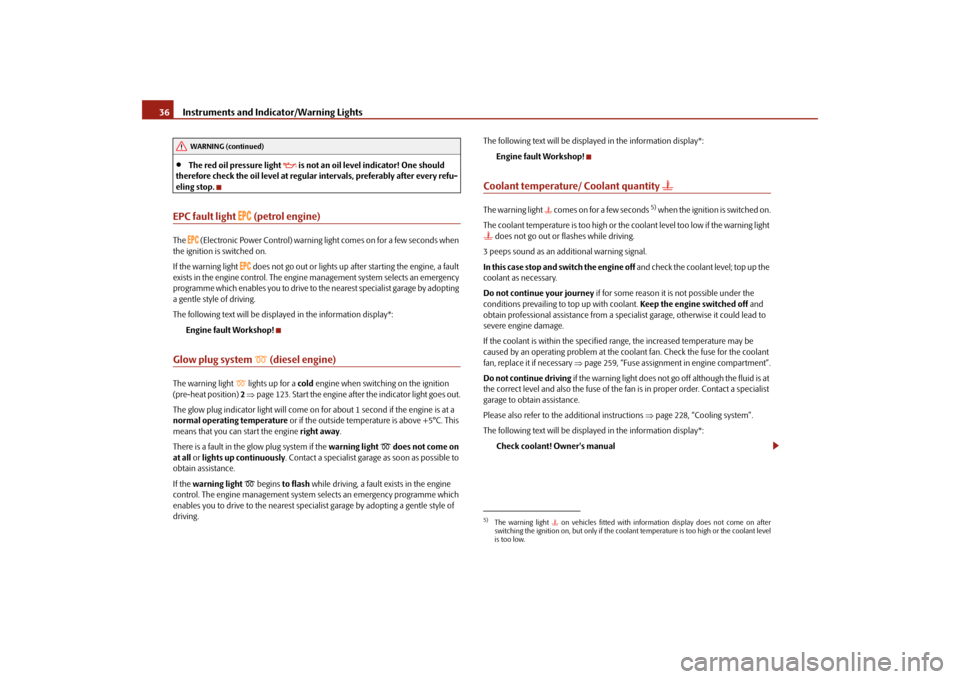
Instruments and Indicator/Warning Lights
36
•
The red oil pressure light
is not an oil level indicator! One should
therefore check the oil level at regular
intervals, preferably after every refu-
eling stop.EPC fault light
(petrol engine)
The
(Electronic Power Control) warning light comes on for a few seconds when
the ignition is switched on. If the warning light
does not go out or lights up
after starting th
e engine, a fault
exists in the engine control. The engine management system selects an emergency programme which enables you to drive to the nearest specialist garage by adopting a gentle style of driving. The following text will be displayed in the information display*:
Engine fault Workshop!
Glow plug system
(diesel engine)
The warning light
lights up for a
cold
engine when switching on the ignition
(pre-heat position)
2 ⇒page 123. Start the engine after the indicator light goes out.
The glow plug indicator light will come on for about 1 second if the engine is at a normal operating temperature
or if the outside temperature is above +5°C. This
means that you can start the engine
right away
.
There is a fault in the glow plug system if the
warning light
does not come on
at all
or lights up continuously
. Contact a specialist garage
as soon as possible to
obtain assistance. If the
warning light
begins
to flash
while driving, a fault exists in the engine
control. The engine management system
selects an emergency programme which
enables you to drive to the nearest specialist garage by adopting a gentle style of driving.
The following text will be displayed in the information display*:
Engine fault Workshop!
Coolant temperature/ Coolant quantity
The warning light
comes on for a few seconds
5) w h e n t h e i g n i t i o n i s s w i tc h e d o n .
The coolant temperature is too high or the coolant level too low if the warning light does not go out or flashes while driving.3 peeps sound as an additional warning signal.In this case stop and switch the engine off
and check the coolant level; top up the
coolant as necessary. Do not continue your journey
if for some reason it
is not possible under the
conditions prevailing to
top up with coolant.
Keep the engine switched off
and
obtain professional assistance from a specialist garage, otherwise it could lead to severe engine damage. If the coolant is within the specified range, the increased temperature may be caused by an operating problem at the coolant fan. Check the fuse for the coolant fan, replace it if necessary
⇒page 259, “Fuse assignment in engine compartment”.
Do not continue driving
if the warning light does not go off although the fluid is at
the correct level and also the fuse of the fan is in proper order. Contact a specialist garage to obtain assistance. Please also refer to the additional instructions
⇒page 228, “Cooling system”.
The following text will be displayed in the information display*:
Check coolant! Owner's manual
WARNING (continued)
5)The warning light
on vehicles fitted with information display does not come on after
switching the ignition on, but only if the coola
nt temperature is too high or the coolant level
is too low.
se0.1.book Page 36 Friday, April 10, 2009 3:19 PM
Page 41 of 304
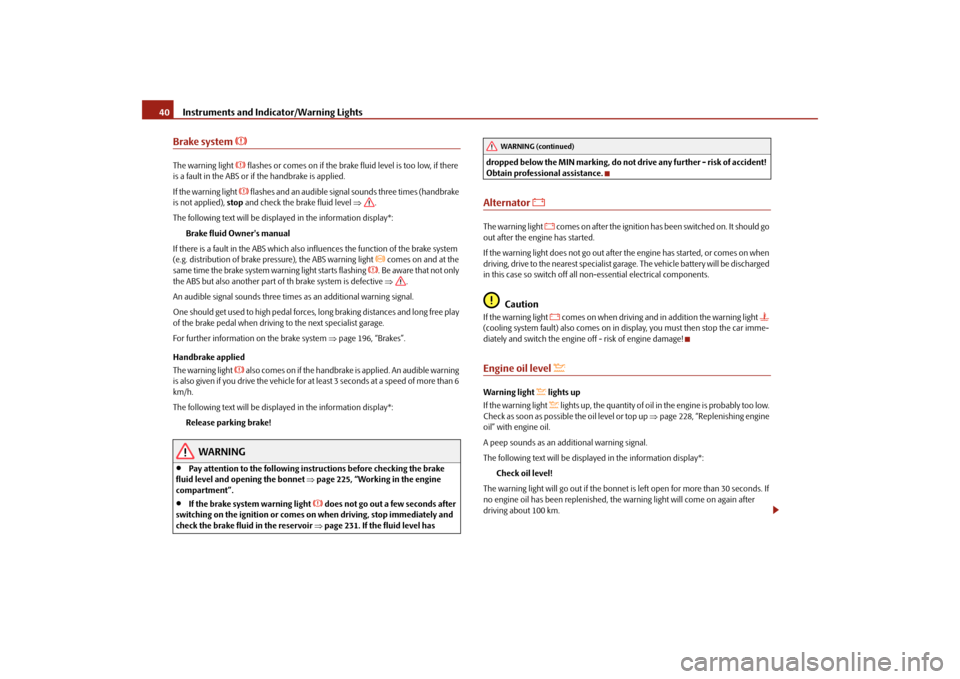
Instruments and Indicator/Warning Lights
40
Brake system
The warning light
flashes or comes on if the brake fluid level is too low, if there
is a fault in the ABS or if
the handbrake is applied.
If the warning light
flashes and an audible signal sounds three times (handbrake
is not applied),
stop
and check the brake fluid level
⇒
.
The following text will be displayed in the information display*:
Brake fluid Owner's manual
If there is a fault in the ABS which also in
fluences the function of the brake system
(e.g. distribution of brake pressure), the ABS warning light
comes on and at the
same time the brake system warning light starts flashing
. Be aware that not only
the ABS but also another part of th brake system is defective
⇒
.
An audible signal sounds three times as an additional warning signal.One should get used to high pedal forces, long braking distances and long free play of the brake pedal when driving to the next specialist garage. For further information on the brake system
⇒page 196, “Brakes”.
Handbrake applied The warning light
also comes on if the handbrake is applied. An audible warning
is also given if you drive the vehicle for at least 3 seconds at a speed of more than 6 km/h. The following text will be displayed in the information display*:
Release parking brake!
WARNING
•
Pay attention to the following instru
ctions before checking the brake
fluid level and opening the bonnet
⇒page 225, “Working in the engine
compartment”.•
If the brake system warning light
does not go out a few seconds after
switching on the ignition or comes on when driving, stop immediately and check the brake fluid in the reservoir
⇒page 231. If the fluid level has
dropped below the MIN marking, do not
drive any further - risk of accident!
Obtain professional assistance.Alternator
The warning light
comes on after the ignition has been switched on. It should go
out after the engine has started. If the warning light does not go out after
the engine has started, or comes on when
driving, drive to the nearest specialist garage. The vehicle battery will be discharged in this case so switch off all non-essential electrical components.
Caution
If the warning light
comes on when driving and in
addition the warning light
(cooling system fault) also comes on in display, you must then stop the car imme- diately and switch the engine off - risk of engine damage!Engine oil level
Warning light
lights up
If the warning light
lights up, the quantity of oil in the engine is probably too low.
Check as soon as possible the oil level or top up
⇒page 228, “Replenishing engine
oil” with engine oil. A peep sounds as an additional warning signal.The following text will be displayed in the information display*:
Check oil level!
The warning light will go out if the bonnet is
left open for more than 30 seconds. If
no engine oil has been replenished, the
warning light will come on again after
driving about 100 km.
WARNING (continued)
se0.1.book Page 40 Friday, April 10, 2009 3:19 PM
Page 125 of 304
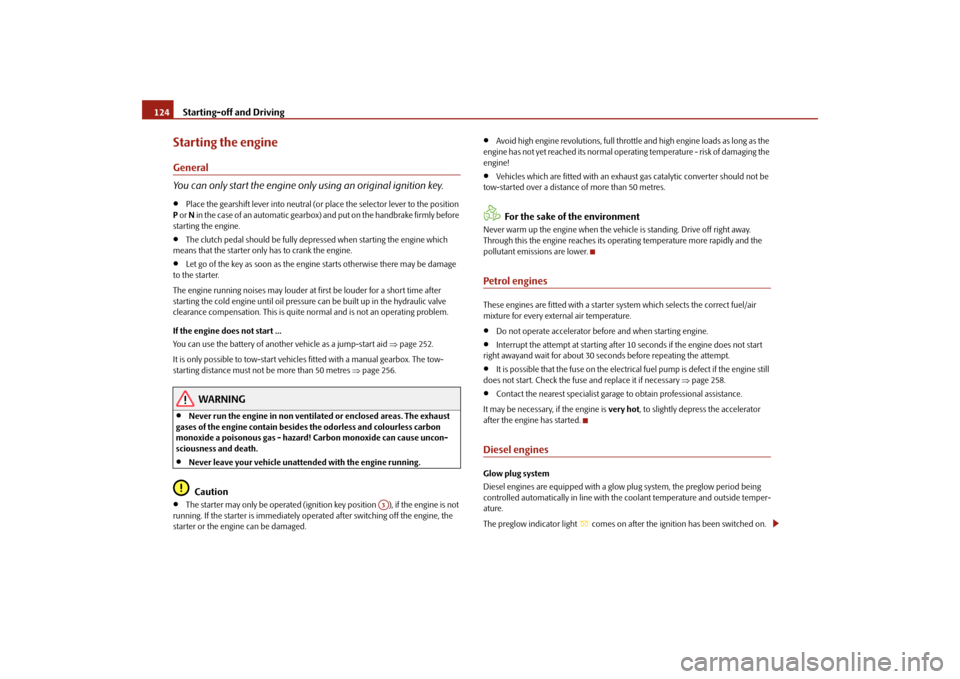
Starting-off and Driving
124
Starting the engineGeneral You can only start the engine only using an original ignition key.•
Place the gearshift lever into neutral (or place the selector lever to the position
P or N in the case of an automatic gearbox)
and put on the handbrake firmly before
starting the engine.•
The clutch pedal should be fully depressed when starting the engine which
means that the starter only has to crank the engine.•
Let go of the key as soon as the engine starts otherwise there may be damage
to the starter. The engine running noises ma
y louder at first be louder for a short time after
starting the cold engine until oil pressure
can be built up in the hydraulic valve
clearance compensation. This is quite no
rmal and is not an operating problem.
If the engine does not start ... You can use the battery of anothe
r vehicle as a jump-start aid
⇒page 252.
It is only possible to tow-start vehicles
fitted with a manual gearbox. The tow-
starting distance must not be more than 50 metres
⇒page 256.
WARNING
•
Never run the engine in non ventilat
ed or enclosed areas. The exhaust
gases of the engine contain besides the odorless and colourless carbon monoxide a poisonous gas - hazard!
Carbon monoxide can cause uncon-
sciousness and death.•
Never leave your vehicle unattended with the engine running.Caution
•
The starter may only be operated (ignition key position ), if the engine is not
running. If the starter is i
mmediately operated
after switching off the engine, the
starter or the engine can be damaged.
•
Avoid high engine revolutions, full throttle and high engine loads as long as the
engine has not yet reached its normal oper
ating temperature - risk of damaging the
engine!•
Vehicles which are fitted with an exhaus
t gas catalytic conver
ter should not be
tow-started over a distance of more than 50 metres.
For the sake of the environment
Never warm up the engine when the vehi
cle is standing. Drive off right away.
Through this the engine reaches its operating temperature more rapidly and the pollutant emissions are lower.Petrol enginesThese engines are fitted with a starter system which selects the correct fuel/air mixture for every external air temperature.•
Do not operate accelerator befo
re and when starting engine.
•
Interrupt the attempt at starting after 10 seconds if the engine does not start
right awayand wait for about 30 seconds before repeating the attempt.•
It is possible that the fuse on the electrical fuel pump is defect if the engine still
does not start. Check the fuse and replace it if necessary
⇒page 258.
•
Contact the nearest specialist garage to obtain professional assistance.
It may be necessary, if the engine is
very hot
, to slightly depress the accelerator
after the engine has started.Diesel enginesGlow plug system Diesel engines are equipped with a glow plug system, the preglow period being controlled automatically in line with the coolant temperature and outside temper-ature. The preglow indicator light
comes on after the igniti
on has been switched on.
A3
se0.1.book Page 124 Frida
y, April 10, 2009 3:19 PM
Page 171 of 304
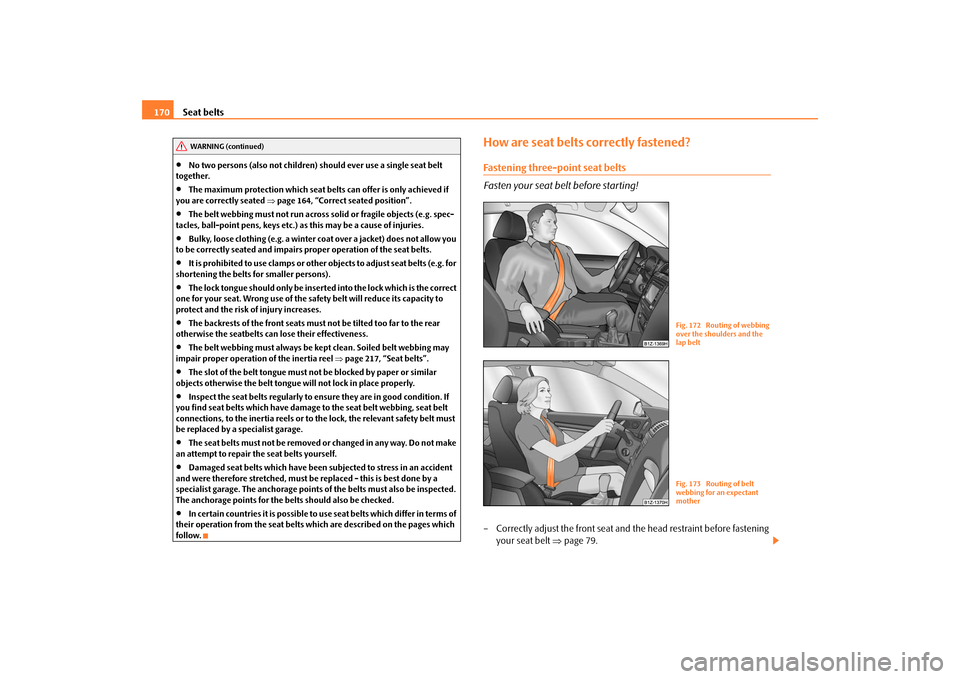
Seat belts
170
•
No two persons (also not children) should ever use a single seat belt
together.•
The maximum protection which seat belts can offer is only achieved if
you are correctly seated
⇒page 164, “Correct seated position”.
•
The belt webbing must no
t run across solid or fragile objects (e.g. spec-
tacles, ball-point pens, keys etc.) as this may be a cause of injuries.•
Bulky, loose clothing (e.g. a winter coat over a jacket) does not allow you
to be correctly seated and impairs proper operation of the seat belts.•
It is prohibited to use clamps or other objects to adjust seat belts (e.g. for
shortening the belts for smaller persons).•
The lock tongue should only be insert
ed into the lock which is the correct
one for your seat. Wrong use of the safety belt will reduce its capacity to protect and the risk of injury increases.•
The backrests of the front seats must not be tilted too far to the rear
otherwise the seatbelts can
lose their effectiveness.
•
The belt webbing must always be ke
pt clean. Soiled belt webbing may
impair proper operation of the inertia reel
⇒page 217, “Seat belts”.
•
The slot of the belt tongue must not be blocked by paper or similar
objects otherwise the belt tongue will not lock in place properly.•
Inspect the seat belts regu
larly to ensure they are
in good condition. If
you find seat belts which have damage to the seat belt webbing, seat belt connections, to the inertia reels or to the lock, the relevant safety belt must be replaced by a specialist garage.•
The seat belts must not be removed or changed in any way. Do not make
an attempt to repair the seat belts yourself.•
Damaged seat belts which have been subjected to stress in an accident
and were therefore stretched, must be replaced - this is best done by a specialist garage. The anchorage points
of the belts must also be inspected.
The anchorage points for the be
lts should also be checked.
•
In certain countries it is possible to use seat belts which differ in terms of
their operation from the seat belts wh
ich are described on the pages which
follow.
How are seat belts correctly fastened?Fastening three-point seat belts Fasten your seat belt before starting!– Correctly adjust the front seat and
the head restraint before fastening
your seat belt
⇒
page 79.
WARNING (continued)
Fig. 172 Routing of webbing over the shoulders and the lap beltFig. 173 Routing of belt webbing for an expectant mother
se0.1.book Page 170 Frida
y, April 10, 2009 3:19 PM
Page 205 of 304
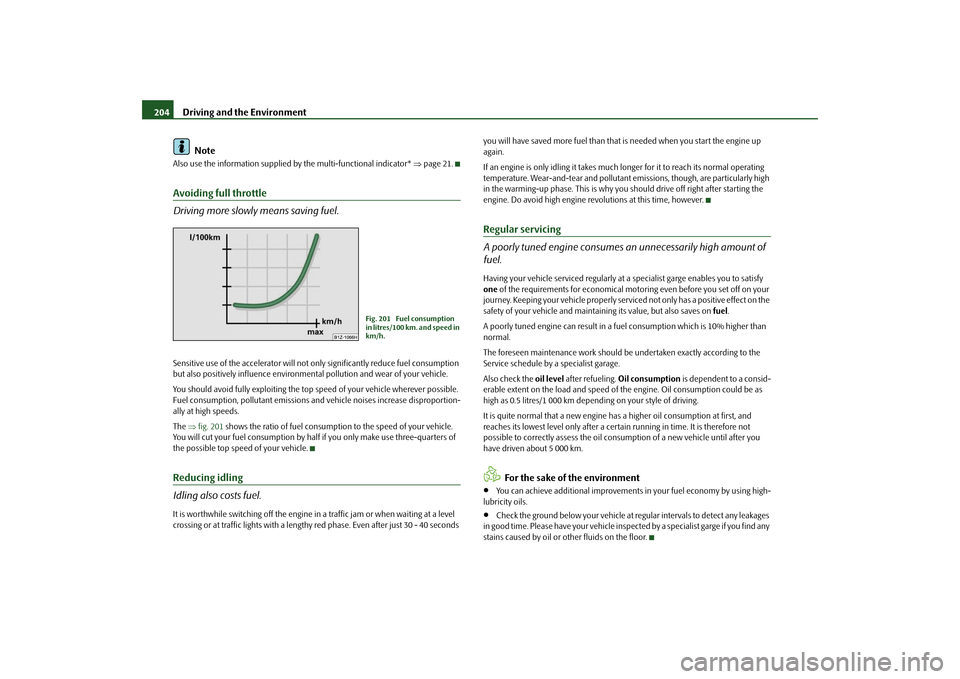
Driving and the Environment
204
Note
Also use the information supplied by the multi-functional indicator*
⇒page 21.
Avoiding full throttle Driving more slowly means saving fuel.Sensitive use of the accelera
tor will not only significantly reduce fuel consumption
but also positively influence environmen
tal pollution and wear of your vehicle.
You should avoid fully exploi
ting the top speed of your vehicle wherever possible.
Fuel consumption, pollutant emissions and vehicle noises increase disproportion- ally at high speeds. The
⇒fig. 201
shows the ratio of fuel consumption to the speed of your vehicle.
You will cut your fuel consumption by half
if you only make use three-quarters of
the possible top speed of your vehicle.Reducing idling Idling also costs fuel.It is worthwhile switching off the engine in
a traffic jam or when waiting at a level
crossing or at traffic lights with a length
y red phase. Even after just 30 - 40 seconds
you will have saved more fuel than that
is needed when you start the engine up
again. If an engine is only idling it takes much
longer for it to reach its normal operating
temperature. Wear-and-tear and pollutant emissions, though, are particularly high in the warming-up phase. This is why you
should drive off right after starting the
engine. Do avoid high engine re
volutions at this time, however.
Regular servicing A poorly tuned engine consumes an unnecessarily high amount of fuel.Having your vehicle serviced regularly at a specialist garge enables you to satisfy one
of the requirements for economical moto
ring even before you set off on your
journey. Keeping your vehicle properly servic
ed not only has a positive effect on the
safety of your vehicle and maintaining its value, but also saves on
fuel
.
A poorly tuned engine can result in a fu
el consumption which is 10% higher than
normal. The foreseen maintenance work should be undertaken exactly according to the Service schedule by a specialist garage. Also check the
oil level
after refueling.
Oil consumption
is dependent to a consid-
erable extent on the load and speed of
the engine. Oil consum
ption could be as
high as 0.5 litres/1 000 km depending on your style of driving. It is quite normal that a new engine ha
s a higher oil consumption at first, and
reaches its lowest level only
after a certain running in
time. It is therefore not
possible to correctly assess the oil cons
umption of a new vehicle until after you
have driven about 5 000 km.
For the sake of the environment
•
You can achieve additional improvements
in your fuel economy by using high-
lubricity oils.•
Check the ground below your vehicle at re
gular intervals to detect any leakages
in good time. Please have yo
ur vehicle inspected by a specialist garge if you find any
stains caused by oil or
other fluids on the floor.
Fig. 201 Fuel consumption in litres/100 km. and speed in km/h.
se0.1.book Page 204 Frida
y, April 10, 2009 3:19 PM